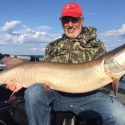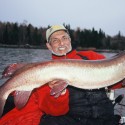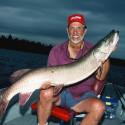The cast was perfect; a long low line drive that powered the big “bucktail” over the small bed of tobacco cabbage. The revolving spool of the bait-casting reel was gently thumbed just before splash down to remove any slack in the line, allowing the angler to kick start the double 10 blades just as the lure touched the surface. Because the lure wasn’t allowed to sink and the big blades were spinning as contact with the water was made, the bulged Cow Girl skimmed the weed tops without picking up any vegetation. The big blades seemed to push the weeds aside as it send out musky-calling vibrations. The calls were quickly answered by a giant musky as it began to track the spinner like a heat-seeking missile zeroing in for the kill. On the first turn of a large figure 8, Jim shouted out “I got it!” I reached for the net and after a short bull-dozing battle the brute was in the net. “Jim” was Jim Saric and along with Dennis Lappen we were filming a TV show for the The Musky Hunter, a high quality, informative show hosted by Saric.
Jim Saric catching another big musky isn’t a big revelation, he has caught many. But the presentation he executed when fishing the weeds is worth noting in this article. In spite of an angler having a great boat, and all the latest gear, and even fishing the same spot, the majority of musky anglers would not have caught this fish! If you made a high looping cast that resulted in excess slack line, you would not have caught this fish. If the lure was allowed to hit the water, sunk a bit, then you switched hands to begin the retrieve you probably would not have caught
this fish. Plus, a cast made over the weed bed to the open water between the weeds and the shore would generally not be attempted by most. Hooking weeds on shorter previous casts would have also ruined the chances of luring the big one out of its lair. This was a good example of how a specific presentation made the difference between catching a musky or not. And this what this article is about; how certain presentations can mean the difference between success and failure
Pulling Them Out of Pockets
Most anglers would rather fish the weeds under lesser light penetration conditions. Early or late in the day, when there is a chop on the water or under cloudier skies are usually considered prime times for catching muskies out of vegetation. These conditions make it easier for muskies to feed, as they leave their hides searching for food. And moving active muskies are always a bonus to those who chase them.
Years ago sunny conditions with little or no wind would tend to keep me out of the weeds, but not anymore. While some muskies move into the weeds to hunt during times of lower light penetration, there are usually some muskies that call the weeds home. And even though these muskies are not actively cruising and looking for food under brighter calm conditions, they are catchable with the right presentation.
Weed growth is usually not the same throughout a good-size weed bed. In a sparse bed thicker clumps may harbor the fish, while in a thick bed pockets often hold the key to success. My approach to pulling muskies out of pockets starts with boat positioning and control. If possible, I’d like to fish the weeds in the direction where I can best see into the water to spot open areas surrounded by thicker weeds. A slower drift is ideal, but gentle bursts from your electric motor would also be a good option. To best see the pockets, a good pair of sunglasses, a long-billed cap with the sides bent down to further reduce glare, and standing as high in your boat as possible are big plusses.
If the weed pockets are deep, say 9-10-feet or more, I’ll generally fish them with a light-colored tube. Generally I’ll underhand pitch them into the pockets, unless the water is real clear and a cast is needed to get more distance. Under hand pitches give me an accurate, quiet presentation and are preferred. The lure should be cast slightly past the pocket and kept high in the water until it reaches the far side of the hole or pocket. I then allow it to sink on a fairly tight line, while giving it slow pumps as it comes through the opening. When you get to the end of the pocket, keep the rod tip up and reel fast to so the lure doesn’t foul up. If you let it sink with a slack line, the leader will be next to the tube on the drop and fish will tend to grab the leader and the lure. If you ever are jig fishing and using a wire leader that is brought in with a twist or curl after a strike (and missed fish) it’s because the fish had the leader in its mouth. A little line tension as the jig sinks will cure that problem. A rod with a little flex in the tip (bucktail action) will give you the best accuracy when fishing a tube lure.
My other finesse weed presentation under sunny, calmer conditions in waters 8-9 feet or less, or if muskies are holding higher in the water column, is using the regular or standard size shallow Bull Dawg. This lure is also preferred in a light color so I can see it. Cast it past the opening and twitch it across the pocket or hole. If a musky is present, there is a good chance it will come roaring out of the pocket to grab the lure. With either of these presentations, if you can’t immediately muscle a musky out of the weeds and it gets buried in the vegetation, go to the fish, get right over it and pull it up with a steady pressure.
Crankbait Tactics
I started cranking the weeds for muskies in the mid 1970’s. At that time there were only a few large crankbaits available, and none went very deep. But I had an “ace in the hole” that gave me the depth I needed to fish the deep weed edges in clearer Wisconsin lakes. My killer presentation at the time was a silver Magnum Hellbender fished with 14-pound test to give me maximum running depth. I used this lure to tick and rip deep weedlines, and to run over shorter fringe grasses outside the deep edge. Few anglers were using speed in this deep zone to trigger strikes, and I had a ball for a few years before I “discovered” another new favorite presentation.
Crankbaits have come a long way since that time with dozens of high-quality plastic, foam and wood divers now available in a variety of fish-catching colors. But in spite of all the musky-catching weapons we now have at our disposal, getting the most of a lure’s potential can make a big difference between success and failure.
My good friend Joe Bucher is a magician when it comes to working a crankbait through the weeds. I’ve seen him preform his magic day and night, shallow and deep; finessing a three hooked crankbait through weeds as if it didn’t even have hooks. For several decades Joe has preached about the right way to crank the weeds to minimize hangs and catch the most fish. Let’s review his technique.
When most anglers contact weeds with their diving crankbait, the natural tendency is to rip the rod to the side. This causes the lure to dive even deeper, which in turn generally plows it further into the weeds. Not only does this foul the lure, it often prevents a strike from a nearby musky that may have struck. The technique that Joe pioneered was to let a buoyant crankbait float upwards after weed contact, then re-start the retrieve . So the whole retrieve consists of tapping a weed, letting the lure float up, tap a weed, float up and so on.
Holding a rod higher or lower helps control a lures running depth. If the lure seems to be plowing into the weeds too much, hold the rod tip higher. You can also use heavier line and shorten your casts a bit. If you are not contacting weeds as much as you’d like, hold the rod tip down to the water and speed up the retrieve, or go to a slightly deeper diving lure.
Bucher’s go to crankbait for weed fishing is his jointed Depth Raider. A jointed lure throws out more vibration that a straight bodied crankbait, and gives the illusion of more speed. The straight-bodied Depth Raider will be used in thicker weeds since it has more buoyancy to float up out of a mess.
Bucher offers these addition tips. He often goes to thinner wire hooks for more lure wiggle and to more easily stick in a muskies mouth if it grabs the lure on the rise. Also the lip of the Depth Raider is often filed down to a near knife edge so it can more easily be ripped through weeds if need be. While I also fish the weeds with Depth Raiders, another excellent weed crankbait is the Shallow Invader. It has good buoyance for the bump and rise, has excellent side to side movement, and the square bill deflects weeds well.
One of the best times to crank the weeds is under the cover of darkness. During those warm summer days when musky activity is at a near standstill, the fish are probably feeding at night. What most anglers envision as perfect night conditions is probably fishing a top water across a calm weed flat. But think about this; during the day a savvy musky angler is probably fishing structures hit by wind. But after dark the calm flats are usually the most sought after locations. Do the muskies move from the windy areas to the calm spots on the other side of the lake? I doubt it. If wind still exists at night, I’d much rather fish the wind with sub-surface crankbaits than look for calmer water to fish top waters! Fish a little tighter to a structure at night than you would during the day, and move the boat about half as fast.
“Watch this” said Bucher while on our annual August filming/fun trip to Lake of the Woods. He had just fired a long cast over a bed of tobacco cabbage with one of his new 9-inch Shallow Raiders we had been testing. The surface was peppered with hundreds of tassels from the surface growing weeds, and he had cast right over the heart of them. As the super buoyant lure entered the weed growth, he began to twitch it right through the cabbage. With the rod held fairly high, and using a slow retrieve that didn’t let the lure dive, along and constant small twitches, Joe finessed the lure right through the cabbage! I tried it several times with the same results-no weeds. The fat, buoyant square-lipped lure parted the weeds as good as any other type lure I would have tried such a spinnerbait or double 10 bucktaiI. I’d like to say a musky charged out of the weeds and grabbed the lure, but I’d be lying. But I certainly can see it happening next year when I add this presentation to my weed-fishing bag of tricks.
To sign up for a free fishing information newsletter, log on to www.spencepetros.com



